Other Raitt Mariners
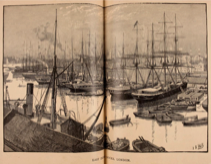
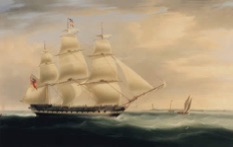
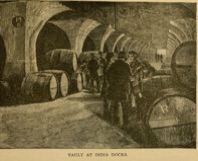
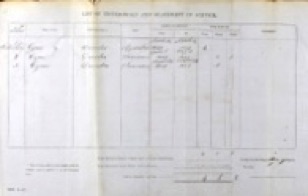
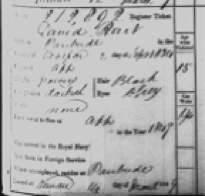
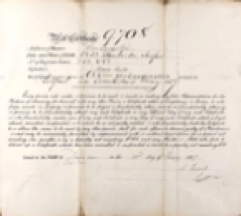

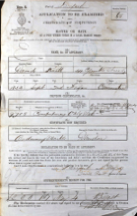
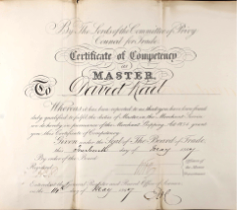
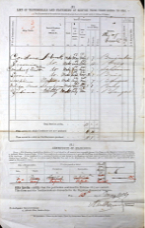
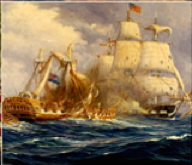
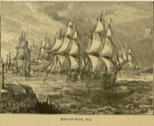

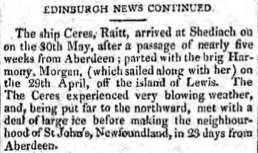
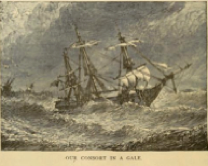
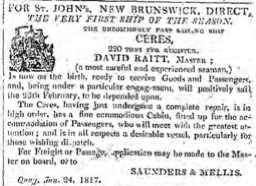
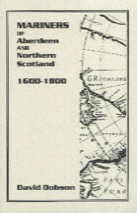
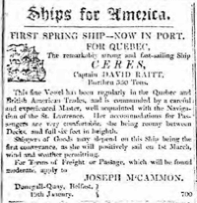
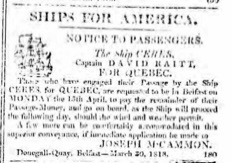
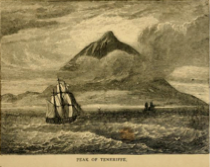
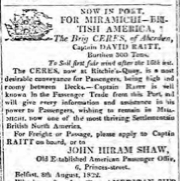
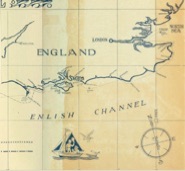
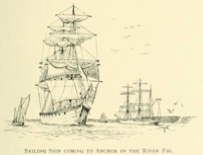
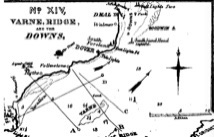
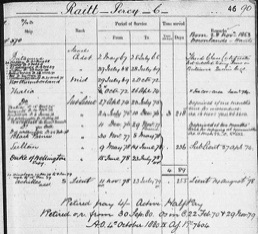
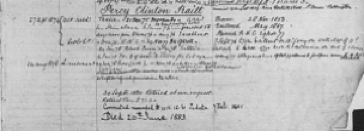
Percy Clinton Raitt (Lymington, England)
Percy Clinton Raitt was born on 28 November 1853 in Hordle, Lymington, Hampshire. He died, aged only 29, on 20 June 1883 and his death was registered in Christchurch, Hampshire. The story of his army ancestors and his descendants in America can be found on the page Hampshire Raitts, but see also California Raitts from South Dakota.
Percy joined the Royal Navy, enrolling on 2 May 1867, when he was just 14. He started off as a cadet, then midshipman, then sub-lieutenant and achieved the rank of lieutenant in 1878. He passed the R.N.C. (Royal Naval College) on 29 November 1877 but it appears he was allowed to postpone various postings during his short career due to ill health.
The record of Percy’s naval career shows that he was born on 28 November 1853 at Downlands, Hants and was a naval cadet from 2 May 1867-28 July 1868 and again from 29 July 1868-28 July 1869 starting off on the Britannia, then Victory, Adelaide, Liffey, Duke of Wellington, Bee and others. He obtained the third class certificate as a cadet. On 18 November 1870 he was deprived of one month’s time for misconduct, and then again on 11 March 1872 he was deprived of two months time for copying at examinations. From 29 July 1869-20 October 1872 he was a Midshipman on the Northumberland, and then served in the same capacity on the Thalia until 27 April 1874 when he was promoted to Sublieutenant. He subsequently served on a number of ships including Mosquito, Himalaya, Duke of Wellington, Excellent, Black Prince and Sultan. He was made Lieutenant on 27 April 1874 and served aboard the Achilles from 11 November 1878- 23 July 1879 after a period of shore leave (sick) from 29 July 1878- 11 November 1878.
On 21 September 1880 he was refused permission to retire, although he was retired on half pay of four shillings, though still on active service active duty. He finally retired at his own request as from 30 September 1880 - probably due to his ill health. His retired pay was £73 per annum. This was commuted and he was awarded £1015 16s and 6p to date 7 February 1881. A note is appended to his service record to the effect that he died on 20 June 1883.
Percy’s uncle, Frederick Alexander Raitt, born 23 January 1839 in Wollangong, near Sydney, Australia was apparently a midshipman in the Royal Navy during the Crimean War. He appears to have enrolled as a Clerk’s Assistant in the Admiralty’s Civil Branch on 10 August 1854, and became an Assistant Clerk on 4 March 1856.
The Belfast Newsletter for Friday, 17 April, 1818 announced that the ship Ceres, under master Raitt, for Quebec with passengers, sailed yesterday morning from Belfast with a very favourable wind. Presumably the ship had been delayed because the newspaper previously announced that the ship was due to sail on 1st March. In fact in the Belfast Newsletter there were a couple of advertisements referring to the Ceres, the first of which appeared on 23 January, 1818.
FIRST SPRING SHIP - NOW IN PORT.
FOR QUEBEC.
The remarkably strong and fast-sailing Ship
Ceres,
Captain David Raitt,
Burthen 350 Tons.
The fine Vessel has been regularly in the Quebec and British American Trades, and is commanded by a careful and experienced Master, well acquainted with the Navigation of the St. Lawrence. Her accommodations for Passengers are very comfortable, she being roomy between Decks, and full six feet in height. Shippers of Goods may depend on this Ship being the first conveyance, as she will positively sail on 1st March, wind and weather permitting. For Terms of Freight or Passage, which will be found moderate, apply to: Joseph M'Cammon, Donegall-Quay, Belfast, 19th January 1818.
Then in the Belfast Newsletter for 31 March 1818, there was the following advertisement:
NOTICE TO PASSENGERS.
The Ship CERES,
Captain DAVID RAITT,
FOR QUEBEC,
Those who have engaged their passage by the ship Ceres for Quebec, are requested to be in Belfast on Monday, the 13th April, to pay their passage money, and go on board, as the ship will proceed the following day, should the wind and weather permit. A few more can be comfortably accommodated in this conveyance if immediate application be made to Joseph McCammon, Donegall-Quay. Belfast, March 30th, 1818.
Ceres sailed again from Aberdeen to America on 8 April 1819, arriving in Quebec in May 1819. She arrived in Pictou from Aberdeen on 19 May 1920; sailed again from Aberdeen to America on 21 August 1820, arriving at Pictou on 22 September 1820, no passengers listed; and sailed again under David Raitt from Aberdeen to America on 12 April 1821.
The Liverpool Mercury for Friday 23 November 1821 announced that the Ceres, under D. Raitt, was in Queen’s Dock [presumably Liverpool], having arrived from Quebec with 57 logs of pine timber, 40 logs of oak, 38 of elm and 14 of ash, plus 20 deals, 30c staves and 6 spars for J. W. Thomas.
The Ceres is next recorded as arriving in Miramichi on 12 May 1822. In this year, the Ceres was clearly back in the emigration business. Both the Belfast Newsletter, Friday, 9 August, 1822 and the Belfast Commercial Chronicle, Saturday, 10 August, 1822 carried the advertisement below:
NOW IN PORT.
FOR MIRAMICHI - BRITISH AMERICA,
The Brig CERES, of Aberdeen,
Captain DAVID RAITT,
Burthen 300 Tons.
To Sail first fair wind after the 16th inst.
The Ceres, now at Ritchie's-Quay, is a most desirable conveyance for Passengers, being high and roomy between Decks. - Captain Raitt is well known in the Passenger Trade from this Port, and will give every information and assistance in his power to Passengers, wishing to remain in Miramichi, now one of the most thriving Settlements in British North America. For Freight or Passage, please apply to Captain Raitt on board, or to John Hiram Shaw, Old Established American Passenger Office, 6, Prince's-street. Belfast, 8th August, 1822.
Sadly, Captain David Raitt was lost at sea on his way to Miramichi on the Ceres. The vessel had left Aberdeen on 14 August 1824, but returned to port on 6 September after her master was struck and knocked overboard by the falling of part of her rigging under circumstances which rendered it impossible for the crew to render him any assistance. Presumably the incident occurred during one of the many storms the Ceres had encountered over the years.
David Raitt clearly lived to fight another day! The Aberdeen Journal for Wednesday 16 March 1814 noted that the ship transport Ceres, Raitt, had arrived in the Downs on 5th inst. after a run of 22 days from Helvoetsluys. Then the Caledonian Mercury for Monday 17 July 1815, announced that the ship Ceres, under master Raitt, arrived at Shediach [Shediac, New Brunswick] on 30 May, after a passage of nearly five weeks from Aberdeen; parted with the brig Harmony (which sailed along with her) on 29 April, off the island of Lewis. The Ceres experienced very blowing weather, and being put far to the northward, met with a deal of large ice before making the neighbourhood of St John’s, Newfoundland, in 23 days from Aberdeen. Other records provide further details of this voyage: the Ceres, 220 tons, master David Raitt, from Aberdeen via Cromarty, Halifax, Miramichi and Shediac with passengers departed 20 April 1815 and arrived at Shediac on 30 May 1815 and at Miramichi on 8 November 1815.
The turnaround time for the Ceres in Canada was clearly a couple of months because the same newspaper for Monday 4 Sept 1815 reported that on Tuesday, the ship, Ceres, Raitt, arrived in Aberdeen bay, on her voyage to Grangemouth, from Bucktush, North America; sailed on the 31 July, and experienced the same night a tremendous storm; as also afterwards, during the passage, very rough blowing weather. Captain Raitt left at Bucktush, the above date, outside the harbour, the Joseph and Jean, and Hope, both of North Shields, the former nearly loaded, and the latter with her lower hold almost full; and in the harbour the brig Seven Sisters, of Aberdeen, about half loaded. Also at Cockton, the brig Harmony of Aberdeen, loaded and cleared for sea, and barque Mayflower, and brig Henry, both of Shields, loaded and waiting water over the bar.
The Caledonian Mercury for Monday 1 July 1816 further reported that the ship Ceres, Raitt, of Aberdeen, passed through Aberdeen bay on Sunday last, for Grangemouth, after a passage of 25 days from Miramichi, being the first arrival from America on the east coast of North Britain this season. – The Ceres sailed on 29 May, five days previous to which the Granite (master Scorgie), of and from Aberdeen, had arrived; left lading the ship Fairweather, expected to be ready in about a week, and the brig Minerva, about half loaded, supposed to sail in a fortnight afterwards; spoke no vessels on the passage, but saw a brig, he believed was the Harmony of Aberdeen, the 3rd instant, on the banks of Newfoundland.
The Aberdeen Journal for Wednesday 5 Feb 1817 carried an advertisement dated 24 Jan 1817 for the Ceres and Captain David Raitt. It was going to sail on 25 Feb for St John’s, New Brunswick, direct and was billed as the very first ship of the season and an uncommonly fast sailing ship. David Raitt, the master, was described as a most careful and experienced seaman. The ship was on the birth, ready to received Goods and Passengers, having just undergone a complete repair. The Ceres, was in high order, with a fine commodious cabin, fitted up for the accommodation of Passengers, who would meet with the greatest attention. It was in all respects a desirable vessel, particularly for those wishing dispatch. It would appear that the ship finally sailed from Aberdeen to St John, New Brunswick with passengers on 4 March 1817 and arrived in St John on 26 April 1817 (36 days from Kirkwall).
David Raitt (Aberdeen)
Captain David Raitt was master of the Ceres, of Aberdeen, and was involved in trade with British North America (i.e. Canada) for a number of years, as well as emigration before his death at sea in 1824. He was most likely from Aberdeen and may very well have owned the Ceres, since he regularly advertised his ship in the local press as a means of transport for goods and passengers. However, it was very probably the same Captain David Raitt who, as master of the Adelphi of Aberdeen, was captured by the Americans on his way to Brazil in a convoy in 1812.
The Aberdeen Journal for Wednesday 30 September 1812 announced that the ship Adelphi, Raitt, of this place, arrived at Liverpool on the 16th curt., after a passage of 22 days from Miramichi. The Aberdeen Journal for Wednesday 30 December 1812 then noted that the ship Adelphi, Raitt, of Aberdeen, bound to the Brazils, arrived at Cork on the 12th instant, to join the convoy. However, in its edition of Monday 26 April 1813, the Caledonian Mercury broke the following story:
“Aberdeen, April 24. We regret to state the capture of the ship Adelphi, David Raitt, of this place, on her voyage from Liverpool to the Brazils, by the Comet, American privateer, of 14 guns and 95 men, of which we extract the following particulars, given in a letter from one of the crew, arrived at Liverpool.
Liverpool, April 19, 1813. We sailed from Cork on the 19th December, and had a fine passage as could be looked for until the 29 the Jan at daybreak, when we saw a schooner coming after us, she then carrying the sea breeze, and we becalmed. We were then within 12 miles of our port, and close in with the land, but carrying the sea-breeze with her, she got between us and the land, and began a heavy fire upon us under American colours. Our Captain told us never to mind him, until he should get close up abreast of us; but to have our guns ready, and to be sure of our aim. I never saw a man behave with more fortitude and coolness that Captain Raitt; for, during the whole time of the action, he went fore and aft of the deck, and when the shot was flying as thick as hail about us, he kept telling us to keep steady. We fought them for 32 minutes at close quarters, the enemy having 95 men, while we could only muster 8 or 9, being all that kept their quarters. At last, our foremast gun choked upon us, and our after-gun upset on the Captain’s leg, and cut it; I really thought it was broken. We had now only two guns of a side to fight, and the Comet had seven, besides 50 men firing with small arms – Had we all stood to our quarters I am sure we should have beat her off; but we were at last obliged to yield. Men and boys were taken on board the privateer, and put in irons, until 8th February, when we were put on board a schooner bound to Roque, which we forced to carry us to Pernambucco.”
By another letter which we have seen, it appears that one American was killed, and two wounded, which, no doubt, led to the severe treatment the crew of the Adelphi experienced, all of whom were plundered of everything belonging to them. Captain Raitt was left on board the Adelphi, which was sent for Baltimore, and hopes are entertained of her re-capture. We are sorry to add, that the rest of the convoy to which the Adelphi belonged, eight in number, have all been captured by the Americans, and the loss, upon the whole, is estimated at 350.000 Sterling livres.”
It is known that Thomas Boyle took command of the Comet in summer 1812 just when President James Madison declared war on Great Britain. Whilst cruising the waters off Brazil between Pernambuco and San Salvador, on 29 January 1813, Captain Boyle sighted a sail to his leeward and tacked in pursuit. The ship hoisted her English colours, with Boyle eventually following suit and both vessels opening fire. Crippled, the English struck their colours and Boyle boarded his prize to discover that she was the Adelphi of Aberdeen, from London bound to Bahia, Brazil, with a cargo of salt and dry goods. The Adelphi was commanded by David Raitt and carried eight 18-pounders as armament. After repairs, the captured Adelphi set sail for the United States, but was retaken by the British before she could reach a friendly port.
He subsequently made an Application to be Examined for the Certificate of Competency as an Ordinary Master to the Local Marine Board for the Port of Belfast on 4 May 1867 for which he paid £2. The certificate was to be issued at Dundee. Here he spells his name Raitt and said he was born 2 Sept 1832 in Carnoustie, Forfor. He was currently residing at 34 Gamble Street (presumably Belfast). He had already certificate of competency number 9708 as Only Mate and had not served in the Royal Navy or Reserve.
As supporting evidence for his Master’s certificate he attached a list of testimonials and statement of service from first going to sea. Interestingly, this relates to his service as Mate, rather than the time served aboard the Cyrus as Apprentice and Seaman.
Cordova, brigantine, registered in Arbroath, rank of mate, from March 1857-Oct 1858 (1 year, 7 months)
Sivonia, brig, registered in Arbroath, rank of mate, from June 1857-Oct 1859 (4 months)
Countess of Siven & Milne, schooner, registered in Arbroath, rank of mate, from Nov 1859-June 1860 (7 months)
Sivonia, brig, registered in Arbroath, rank of mate, from Sept 1861-Nov 1863 (2 years 1 month)
Josephine, barque, registered in Montrose, rank of mate, from Aug 1864-Mar 1865 (7 months)
Eliza Jane, brig, registered in Shoreham, rank of mate, from April 1865-May 1866 (1 year 1 month)
Zodiac, barque, registered in Whitby, rank of mate, from July 1866-Mar 1867 (8 months)
He spent a total time at sea was 18 years, for which certificates for time served were produced for 6 years, 11 months.
The certificate of the examiners has been amended in red. The date of the examination was changed from 7 May to 10 May, the failure in Navigation was changed to passed; the mark in Seamanship was changed to passed, and it was noted failed for alarms, codes and signals. The rank for which passed is given as OC and the document is dated 10 May 1867. He was awarded his Certificate of Competency as Master in the merchant service on 14 May 1867 – given under the seal of approval of the Board of Trade. He also received Certificate 9708 at Dundee on 22 May 1867 after having passed an Ordinary Examination at Belfast on 7 May 1867. Interestingly, here his name is spelled Raitt – born 1832 in Panbride, Fofar, but residing in Carnoustie, registered ticker 212, 882.
In the 1851 census for 121 Blacks Croft, Dundee we find David Rait, aged 18, an apprentice seaman, born Panbride, Angus as a lodger in the Clark household.
In 1861, living at Shore, Arbroath, is David Raitt, aged 29, seaman in the merchant service, born Panbride, married. His wife is Jane, aged 27, born in Evanton, Ross and Cromarty. Also in the household is Barbara Robertson, aged 17, general servant, also born in Evanton.
David Rait(t) (Dundee)
David Mitchell Rait was born in Panbride, Angus on 2 September 1832, christened 16 September, to William Rait and Margaret Paterson. He was actually aged 15 when he was ticketed (though this might be because his date of birth was given as 2 Sept 1834) and he first went to sea as an apprentice in 1849. He had black hair and a darkish complexion and grey eyes. He could also write. When unemployed he resided in Panbride.
As David Rait, he made an Application to be Examined to the Local Marine Board for the Port of Dundee for obtaining the Certificate of Competence as an Only Mate on 2 February 1854. The application was no. 40 for which he paid the fee of £1. He gave his residence as Panbride, Forfarshire, where he was born on 2 Sept 1832. The number of his registered ticket was 212882. His List of Testimonial and Statement of Service contains the following ships:
Cyrus, belonging to Dundee, served as Apprentice, from 14 March 1849-14 March 1853 (4 years)
Cyrus, belonging to Dundee, served as Seaman, from 1 June 1853-19 Aug 1853 (2 months 3 weeks)
Cyrus, belonging to Dundee, served as Seaman, from 30 August 1853-26 October 1853 (3 months)
The 177 ton Cyrus seems to have been built in 1834. David had certificates for total time at sea of 4 years. 5 months, 3 weeks. He was given his Certificate of Competency as Only Mate under the seal of the Board of Trade on 8 Feb 1854 after he had passed an Ordinary Examination in Dundee on 4 Feb 1854. Another certificate, numbered 9708, was issued on 13 February 1854.
Arthur Grainger Raitt served as an Ordinary Seaman, Able Seaman, Signalman and Engine Room Artificer in the Royal Naval Volunteer Reserve Division Service (Clyde) during the 1st World War. After he was demobbed in February 1919, he became an engineer with the Shanghai Tug and Lighter Co. in China. His wartime service record reveals that he was aboard diverse vessels continuously from October 1914 to February 1919 in various capacities. The ships on which he served as well as his family details will be found on the Kincardineshire Raitts page.
A much earlier record reveals that Robert Raitt, who married Margaret Orock in Montrose on 17 June 1671, and whose daughter, Margaret Raitt, emigrated to America and died in Virginia in 1714, was a Master Mariner. He could be either the Robert Rait, christened in Montrose on 27 Nov 1632, father Andro Rait; or the Robert Rait christened in Montrose on 9 February 1638, father George Rait; or the Robert Raitt, christened on 25 May 1640 in Montrose, father William Raitt.
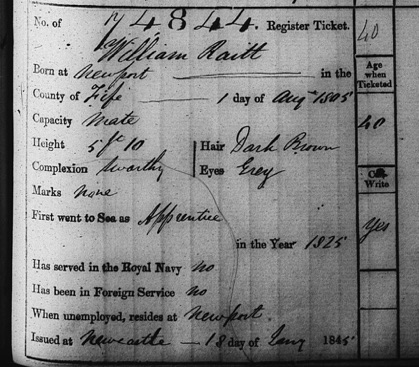
William Raitt (Fife)
William Raitt, was born on 1 August 1805 at Newport, Fife. His Register Ticket was 74844, issued on 18 August 1845 at Newcastle, and he was ticketed at age 40 in the capacity of Mate, having first gone to sea as Apprentice in 1825. He was 5ft 10in tall, had a swarthy complexion, dark brown hair and grey eyes - and he could write. He had not served in the Royal Navy nor been in Foreign Service. When unemployed he resided at Newport. He seems to have died before 1851. The parish of Forgan and Newport are just across the River Tay from Dundee, Angus - so William Raitt may well have been related to other sea-faring Raitts nearby. If this is the right William (see Perthshire Raitts), then he was the grandfather of the surgeon in Nicaragua named Oswald Raitt.
I have provided on their own pages details of various master mariners named Raitt, from Arbroath, such as my great grandfather David Dorward Raitt and his brother James Dorward Raitt, their father John Raitt and his brother Alexander. Other relatives (such as Alexander Croal, Robert Stormont and various Dorwards), together with other Raitts from Arbroath who may or may not be relatives are given on the Arbroath Mariners page.
However, there are also a few other Raitts who were captains and since they are reasonably well documented in the press and elsewhere then I thought it might be helpful to include a page about them. This page then covers some of these other merchant seamen captains including David Rait(t) of Dundee and David Raitt of Aberdeen. Since new aspects about the career of Charles Raitt of Dundee have been made known, then the details about him have now been moved to hiw own separate page. The exploits of Captain William Raitt, of Aberdeen, who saw much action in the first decade of the 1800s in the Royal Navy ship HMS Scout are given elsewhere, together with a few other Raitts (Captains David Raitt of Dundee and George Raitt of Aberdeen), on a new page Raitt Mariners in the Napoleonic Wars.
Details of the required examinations these sailors would have had to have passed to gain their master’s Certificate of Competency are given on a separate page, as is some of the flavour of what it took to be a Master Mariner in the days of sail. A separate page covers some shipwrecks in which various Raitts and their relatives were involved.
----------
It is instructive to learn a little about the turnaround time in ports (where in the early days probably much of the loading was done manually rather than by huge derricks) as well as the conditions faced at sea and the delays faced in sailing – waiting for tides and favourable winds. What is also interesting is the fairly detailed reports of ship departures and arrivals, passage time and so on. Presumably this was more for the local merchants than the public, since, for instance, the Belfast Newsletter is full of notices and advertisements by people wishing to sell timber or Tenerife wines or cotton or American hops newly arrived on ships or wanting to buy certain goods or looking for ships to transport their goods to various places. It is also indicative of the time taken to obtain news. For instance, the date of a ship’s arrival in Quebec from Aberdeen or wherever would depend on that information being brought back by another ship. This is also indicative of the way that ships looked out for each other and were “spoken to” along the way and sailed along with each other for reasons of safety in tempestuous and hazardous seas as much as anything.
----------
Since the Downs is mentioned several time in connection with the bigger sailing ships, then I thought it might be worth giving a little more details (initially for my own edification). The following is mainly taken from Wikipedia.
The Downs are a roadstead or area of sea in the southern North Sea near the English Channel off the east Kent coast, between the North and the South Foreland in southern England. In 1639 the Battle of the Downs took place here, when the Dutch navy destroyed a Spanish fleet which had sought refuge in neutral English waters. From Elizabethan times, the presence of Downs helped to make Deal one of the premier ports in England, and in the 19th century, it was equipped with its own telegraph and timeball tower to enable ships to set their marine chronometers. The anchorage has depths down to 12 fathoms (22 m). Even during southerly gales some shelter was afforded, though under this condition wrecks were not infrequent. Storms from any direction could also drive ships onto the shore or onto the sands, which - in spite of providing the sheltered water - were constantly shifting, and not always adequately marked. The Downs served in the age of sail as a permanent base for warships patrolling the North Sea and a gathering point for refitted or newly-built ships coming out of Chatham Dockyard, and formed a safe anchorage during heavy weather, protected on the east by the Goodwin Sands and on the north and west by the coast. The Downs also lie between the Strait of Dover and the Thames Estuary, so both merchant ships awaiting an easterly wind to take them into the English Channel and those going up to London gathered there, often for quite long periods. There are records of as many as 800 sailing ships being at anchor there at one time.
Unfortunately, pre-1845 there was no system of examination or qualification to become a master mariner, and therefore there are no separate records for masters before this date. This means that we do not have much information about Raitt captains and mates beyond what is mentioned in the shipping news in various newspapers. All the vessels below were captained by a Raitt (sometimes spelled Rait) - but his first name is not known, nor his age or place of birth, and it may have been the same person who skippered different boats. Some of the exact details can, however, be gleaned from other mentions.
The Speedwell sailed from Aberdeen for Leith on 11 July 1795.
The Lively lying on birth taking on goods in Leith for Aberdeen and place adjacent on 27 October 1795. [This is Captain George Raitt - see story on his capture on the Napoleonic Wars page. George Raitt, many years a respectable shipmaster in Aberdeen, died on 1st June 1811 in the 44th year of his life.]
The Lively arrived in Aberdeen on 11 July 1796 with goods from Leith and returned from Aberdeen to Leith carrying goods on 19 July 1796.
William Gorie, of the Mary of Dundee sailed from Riga on the 6th of July last [1799] with a cargo of Flax of hemp for this port, and on the 14 of said month of July fell in with a very heavy Gale of Wind @ WNW in the Lat 55"38 Long 16"20. Sea making passage over the Vessel. Then protested that whatever damage the Ship or Cargo might sustain was entirely owing to the Storm. Adduced David Rait, Mate & David Whyte Mariner both on board said Vessel arrived here yesterday.”
The Hope sailed from from Riga to Montrose with flax on 9 December 1800.
The Jessie sailed from Dundee to St Petersburgh carrying ballast on 15 August 1806 and returned to Dundee with flax on 21 August 1806.
The Primrose sailed from London for St Petersburg with ballast on 6 September 1806. The ship sailed from Aberdeen for Riga with ballast on 13 June 1807.
The Arethusa sailed from Dundee to Liebau with ballast on 7 April 1807, returning from Riga to Dundee carrying flax on 12 June 1807. [This is probably Captain David Raitt - see his escape story on the Napoleonic Wars page.]
The Nymph [of Dundee] sailed from St Petersburgh to Dundee carrying flax on 22 October 1806 and sailed from Riga to Dundee on 12 November 1807. The Nymph carried a letter from Riga dated 12 November 1807 saying that an order from St Petersburgh stated that all merchant ships of whatever nation, that should not sail in five days, would not be permitted to depart. The letter brought by Nymph arrived there (Dundee) on 1 December - the ship sailed in consequence of the order, from Riga, on 13th from the Sound, with convoy, on 23rd and parted same day [from the fleet] in a gale of wind in the Cattegat.
And it was mentioned that a William Raitt was a shipowner in Stonehaven in 1806.
